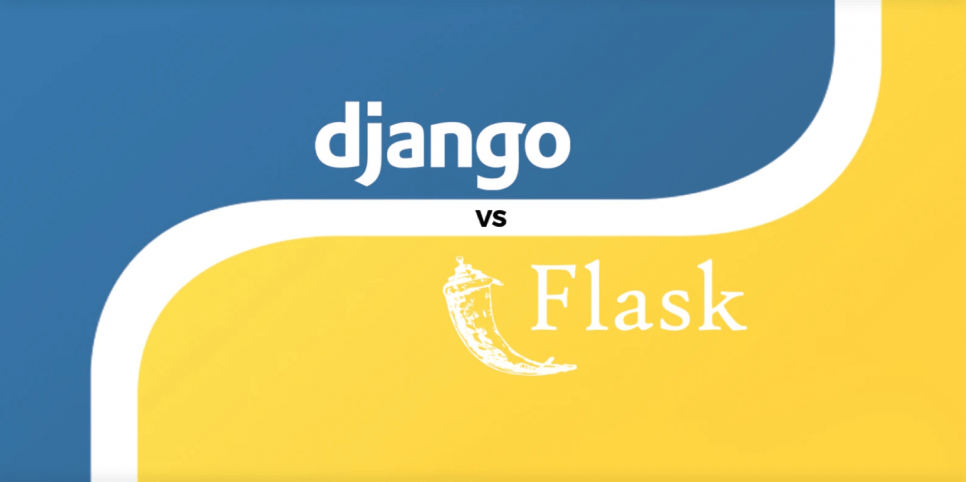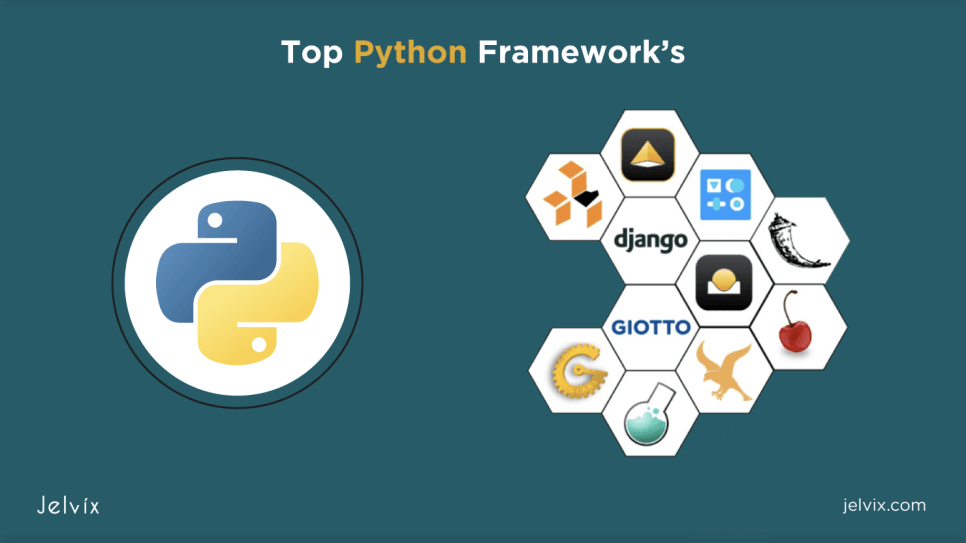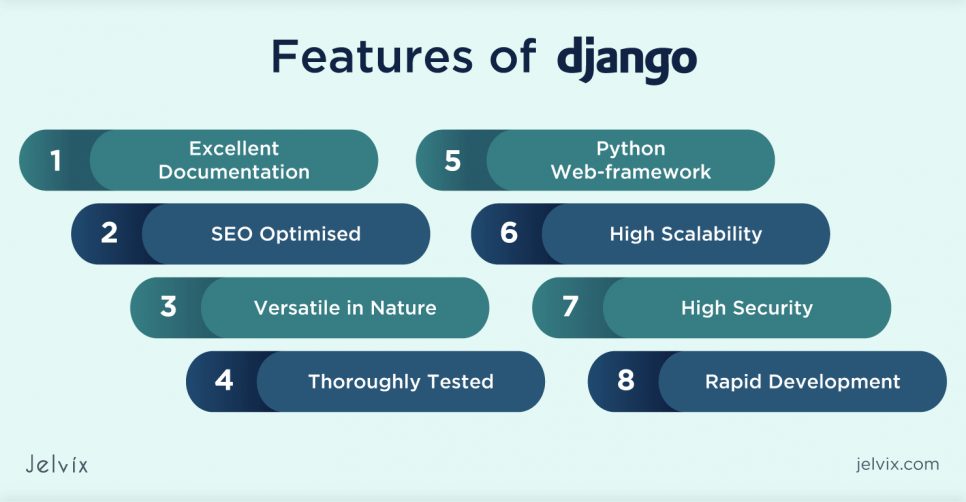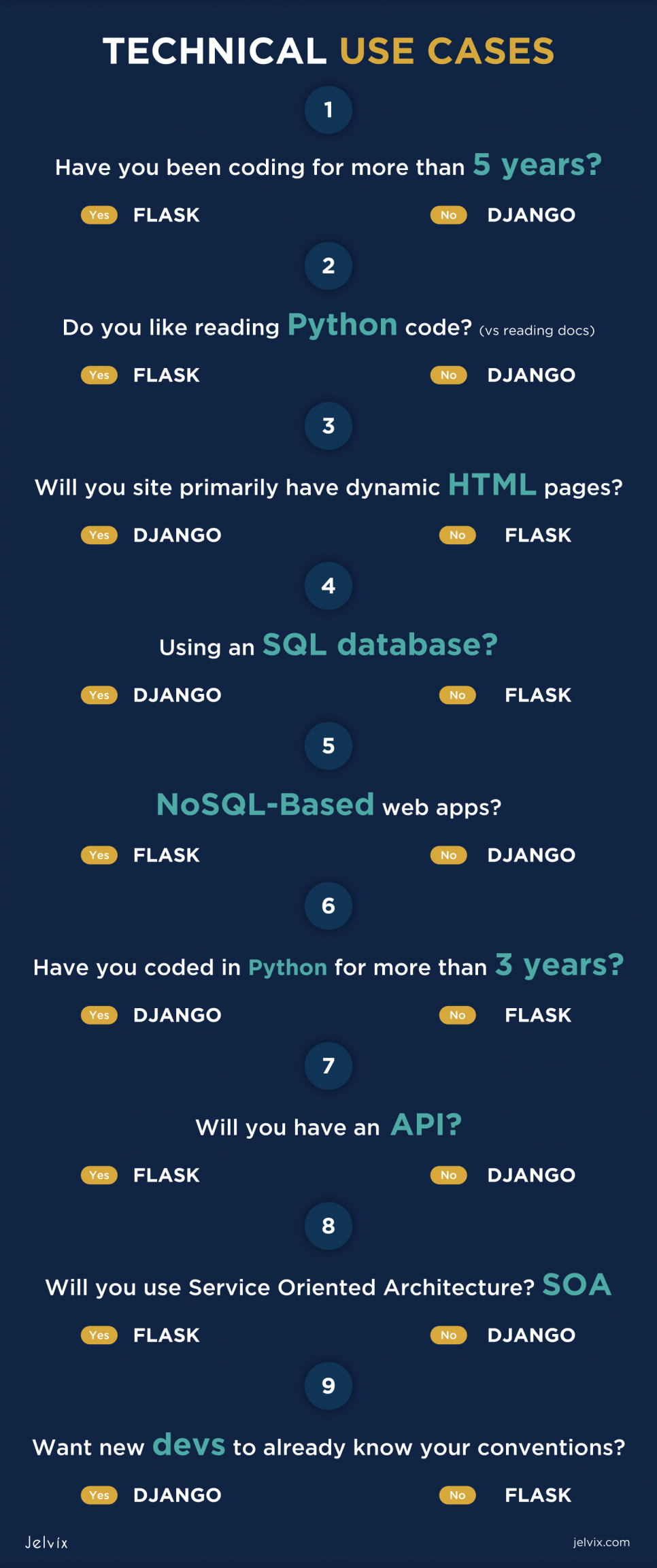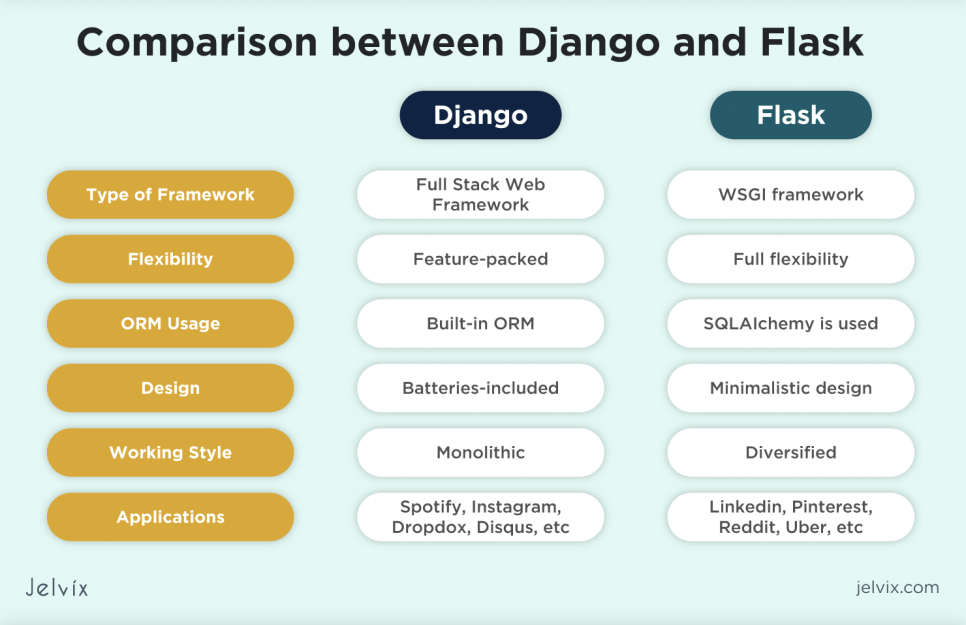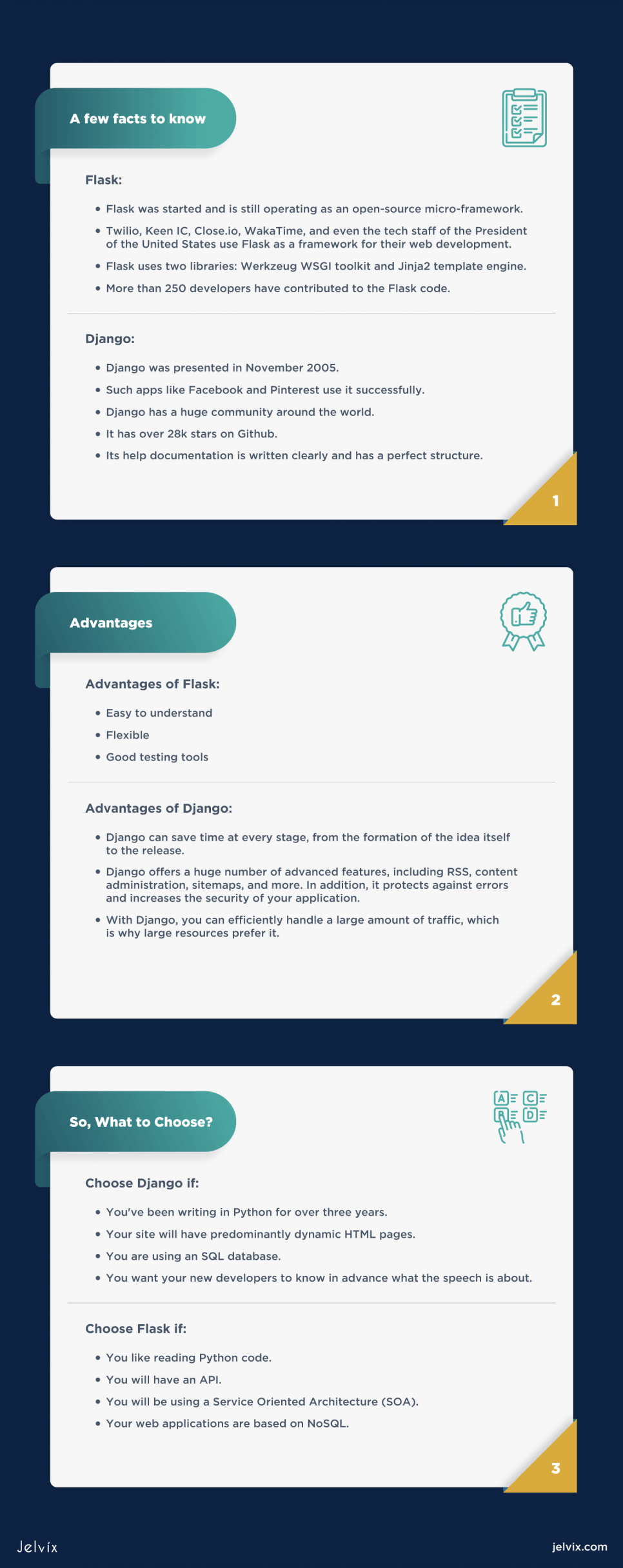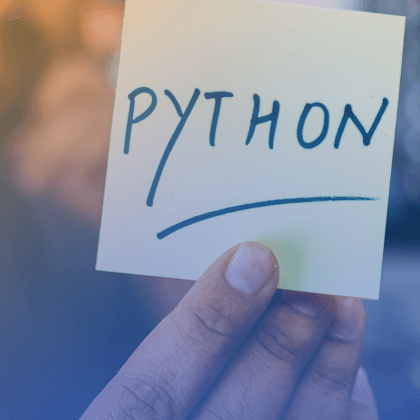Let’s talk about Python Django vs Flask frameworks’ competition and how to choose a framework according to the project’s specificity.
Python Frameworks Review
Python frameworks help to simplify devs’ lives and provide a wide variety of opportunities for creating useful apps or sites. Many solutions are easy to automate, processes can be accelerated, and tedious tasks – minimized. In Jelvix, we mainly use the popular ones – Django or Flask, but we can tell a lot about other frameworks as well.
In fact, their functionality varies considerably. Some are made for full-fledged complex multi-level development, while others have a simplified interface that allows you to develop individual modules and blocks. Before choosing what environment to work in, you need to define your objectives and understand goals. Having done this, you will see clearly what exactly to use.
CherryPy
CherryPy is a micro-framework. It is designed to overcome specific troubles and is capable of running a program on any operating system. It isn’t used for global goals. CherryPy allows you to work with any type of technology suitable for templating, data access, etc. It can also handle articles, statics, cookies, upload files, and everything else that other frameworks can do.
Pyramid
Python framework Pyramid is created for programming complex objects and solving multifunctional problems. It is used by professional programmers and is traditionally used for identification and routing. It is aimed at a broad audience and is capable of developing API prototypes.
Grok
Grok is a Python framework for templating. Its main task is to ensure that it does not repeat itself in the code, helping the developer. In case the element is reused, the template that has already been created earlier is applied simply. This simplifies the work dramatically and speeds it up.
TurboGears
TurboGears is an open-source framework for building web apps. It gives an opportunity to create high-quality, interesting applications, has convenient templates, flexible ORM, and supports many databases. It is a versatile development environment that is convenient for both beginners and experienced programmers.
Web2Py
Web2Py is a scalable framework with its own IDE. This means that it contains a debugger, code editor, and deployment. It works great without configuration or installation, provides data security on a high level, and is suitable for work on various platforms.
Bottle
Initially, Bottle was developed exclusively for creating an API, but later the functionality was slightly expanded. Lots of features are included by default: utilities, templates, and more. It’s perfect for prototyping. While Bottle is so minimalistic, it has many features that are enough for small to mid-range projects.
Tornado
Tornado is the ideal one for heavy and massive apps that can handle over 10,000 connections simultaneously. Besides, you can expand the possibilities for high visitor traffic, for example, a feed aggregator for several social networks or RSS. It also offers built-in support for user authentication.
BlueBream
BlueBream used to be called Zope3. It copes well with tasks and is suitable for working on serious projects due to its complexity. The framework uses a transactional object DBMS, which provides an easy way to implement data storage.
Sanic
Sanic is built on top of uvloop, and its main purpose is to process HTTP requests quickly. Sanic supports asynchronous request handlers. Sanic has excellent and clear documentation that community members write for the community itself. This framework is very similar to Flask open source web server and Python web framework.
Quixote
Quixote is a platform for developing web apps with open source. It has high performance and flexibility. It is designed to work with traditional apps and follows the basic rules of Python programming. Quixote can only work with Python 2.4 and later, so you need to keep an eye on updates.
Dash
Dash is another open-source framework. Its primary purpose is to create analytical web applications. Applications built using this framework can be deployed on servers and are essentially cross-platform.
Let's compare standalone advantages and drawbacks of Python and Nodejs and then put them side-by-side for exact comparison by crucial criteria.
What is Flask?
Let’s start the Django vs Flask battle by understanding their cores.
The Python Developer Survey (2019) tells that Django and Flask are the most well-known frameworks among developers. You can hardly go wrong with choosing one of these frameworks to work with a new web app. While picking which one will work best for you and your goals, there are several clear differences to keep in mind.
Django has been around for longer – the first edition was in 2005, while Flask was introduced in 2010.
Flask is a really popular framework that’s widely used today. Flask resembles a LEGO constructor, which you can use to build whatever you want using Python libraries or Flask extensions. Python developers from Jelvix say that with Flask, you can add new modules when you need them, rather than being bombarded with details for the first time.
Some interesting Flask details:
- Flask was started and is still operating as an open-source micro-framework.
- Twilio, Keen IC, Close.io, WakaTime, and even the tech staff of the President of the United States use Flask as a framework for their web development.
- Flask uses two libraries: Werkzeug WSGI toolkit and Jinja2 template engine.
- More than 250 developers have contributed to the Flask code.
On Github, Flask has over 4,200 changes, over 54,700 stars, and almost 14,300 users following its changes.
Flask Features
Flask likes simplicity and minimalism. There are no ORM or database access layers here. More applications like SQLAlchemy or SQL do the job without any restrictions.
Routing with decorators is easy: the structure of the application is also fully customizable. The wide variety of module copies for your app are endless. Using the ones that best suit your task, you can design your app as if playing LEGO. These extensions are beneficial in the development and integrate easily into the framework.
Flask provides simple functionality, so the Jinja2 template engine works perfectly.
Flask contains a built-in webserver and all needed debugging tools. You can avoid using NGINX or Apache but still find bugs in your app.
Flask emerged as a substitute to Django since the developers needed a micro-framework that allowed them to use a wide range of components. None of the previous frameworks allowed modifying their modules to that extent. Flask gives freedom of action that will surely please an experienced developer. You can always choose which databases, third-party libraries, or flask extensions to use in this particular case.
Advantages of Flask
Flask is known as the best web framework for building lightweight web applications and small static sites. While working with Flask, we’ve found some good and bad points and want to share them with you.
Pros
1. Easy to understand
Even a novice programmer can understand how to work with the framework. Flask has a simple structure and intuitive syntax. In addition, unlike other frameworks, Flask allows programmers to have complete control over the development processes.
2. Flexible
Only some parts of the framework are inaccessible for modifications because they are already as simple and optimized as possible. Programmers can independently edit most of the framework tools to suit their needs. With Flask, the programmer gets a templating engine that allows the same user interface to be used across multiple pages.
3. Good testing tools
Flask has integrated testing and debugging tools. Developers have full-fledged unit tests, a built-in development server, a debugger, and a request handler at their disposal.
Disadvantages of Flask
While Flask is easy to learn, it is common for novice developers to write such bad code that a web application is terrible.
1. It doesn’t support asynchrony
Flask processes all requests in one thread; that is, each request blocks the thread for the duration of its execution and then passes the queue to the next request. If we draw a simple analogy, it is like only one working cash register in a supermarket, with a large number of customers (requests), the cash register will not cope, and a large queue will form.
2. Lack of opportunities
When it comes to developing large web applications, Flask simply lacks capabilities.
What is Django?
Django is a highly demanded framework that has gained immense popularity among Python application developers. It is open-source. Actually, it can even be called a code library with templates for reliable and maintainable applications. Django is interesting because it has stable ways of working with some modules. You can choose them when you need them, saving you a lot of time, money, and effort, getting all the solutions right out of the box.
A few facts to know:
- Django was presented in November 2005.
- Such apps like Facebook and Pinterest use it successfully.
- Django has a huge community around the world.
- It has over 28k stars on Github.
- Its Help documentation is written clearly and has a perfect structure.
On Github, Django has over 2,953 changes, over 57,100 stars, and almost 24,400 users following the changes.
Django Features
Django gives ORM, and it’s up to you what kind of databases to choose (MySQL, PostgreSQL, Oracle, etc.). You can choose asynchronous tasks and switch the Unix crontab with cron jobs. As well, one can select Gunicorn instead of Apache. If your developers are experienced enough, you can use MongoDB as your main database: this will overcome a lot of problems later (we’ve experienced this during one of our client’s projects).
You can avoid disruption and chaos by choosing named URLs and getting a logically structured system as a result.
Using a supervisor to monitor processes allows reloading the process of the framework automatically if necessary, which is extremely important during the dev stage. Redis is a useful in-memory data structure store that can be used to organize a celery task queue, like a cache, as well as a session store, and more, including autocomplete.
If you take a look at our portfolio, you will notice that the framework is perfect for working with highly scalable applications that expect large flows of clients. Almost all main functions come out of the box, so it is convenient and profitable.
Advantages of Django
Django makes it possible to implement any idea in a matter of hours, saving developers from wasting time by focusing on functionality. The framework is freely available, so it is the best tool for startups that usually do not have large budgets but need to make a name for themselves.
- Django can save time at every stage, from the formation of the idea itself to the release.
- Django offers a huge number of advanced features, including RSS, content administration, sitemaps, and more. In addition, it protects against errors and increases the security of your application.
- With Django, you can efficiently handle a large amount of traffic, so large resources prefer it.
Django Disadvantages
While we love Django, it’s not perfect for the following reasons:
- Django uses a URL Routing Pattern;
- It is too monolithic;
- It is totally based on ORM Django;
- Django has all components deployed together;
- It can own the entire system to work.
Difference Between Django and Flask
Flask and Django are mature, extensible web frameworks that fundamentally provide similar functionality in handling requests and maintaining documents but differ in scope.
Most of the differences between the two frameworks stem from different approaches, the rest from excellent basic design decisions. Here are a few key differences that might influence your decision:
Request object – Flask uses local streams, and Django passes the request where it needs to be.
Forms – Django is available with built-in forms that integrate with the ORM and site admin area. Flask doesn’t support forms by default, but you can use WTForms to fill that gap.
Databases – Django is available with a built-in ORM and migration system that can manage databases. Flask doesn’t do that, but tools like SQLAlchemy provide similar functionality (or even more).
Authentication and User Privileges – Django provides an authentication application that provides a default implementation for user control and privileges. Flask provides secure cookies as a tool for your own implementation.
Admin Panel – Django includes a fully integrated admin interface for managing application data. Flask doesn’t have these features, but Flask-Admin is a very popular extension that can be used to create a similar admin tool.
So, Django has its own Django ORM and uses data models that help databases and classes be friends with each other, while Flask lacks both. To put it simply, Flask is more modular.
But the huge difference is that Django provides a Model-View-Controller to the developer, completely simplifying the process of creating an application. It has less code, and you can use components many times.
As a microframework, Flask provides you with a basic set of development tools. It is great for single-page applications. You can apply it to blogs or small sites. On the other hand, Django is a choice for large projects.
So, What to Choose?
The difference between Django and Flask is widely discussed. We’ll give you a few clues when it is best to use each of these frameworks.
So, choose Django if:
- You’ve been writing in Python for over three years.
- Your site will have predominantly dynamic HTML pages.
- You are using an SQL database.
- You want your new developers to know in advance what the speech is about.
Choose Flask if:
- You like reading Python code.
- You will have an API.
- You will be using a Service Oriented Architecture (SOA).
- Your web applications are based on NoSQL.
Conclusions
In general, if you need to choose in Python Flask vs Django dilemma, you should start with your goals. Django is a framework ideal for startups and large companies. You get all the tools you need, and you can get what you want quickly.
In short:
· Flask is perfect if you need more control over your components, as a minimalist framework requires you to add each new component yourself.
· Django is the go-to choice if you’re interested in the final product. Especially if you are working with a straightforward application such as a news site, store, blog and always need one transparent way to accomplish a particular task.
Today, the Django community is larger, and its documentation is better. If you suddenly need something other than what this framework offers out of the box, it will be much easier to find a ready-made solution (e.g., requesting advice from the community).
The main features (and at the same time advantages) of Flask are minimalism and simplicity. If you suddenly want to add something special that is not covered with an add-on yet, finding a solution with help from the community will be somewhat difficult.
And finally, about the throes of choice and the difference between Flask and Django.
Choose Django for a medium to large site. If the site has dynamic content with a database of data and user authentication, it will be easier and faster to create it with Django.
If you are in for a minimalistic site, then Flask is the best choice. It will also come to the rescue if your site assumes a complex structure with individual features, for example, some special database with a choice of a large number of components and solutions.
Need a qualified team of developers?
Use our talent pool to fill the expertise gap in your software development.


